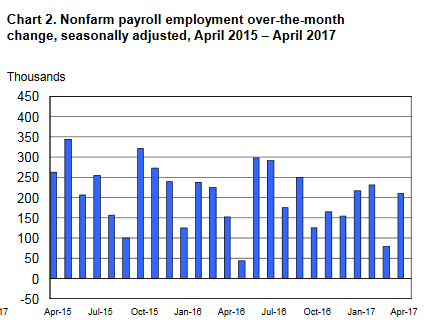Employment Blog May 2017
Nonfarm payroll employment increased by 211,000 in April, and the unemployment rate, at 4.4 percent, was little changed. Thus far this year, monthly job gains have averaged 185,000, in line with average monthly job growth in 2016. In April, job gains occurred in leisure and hospitality, health care and social assistance, financial activities, and mining. These results are detailed in Charts 1 and 2 below.
Leisure and hospitality added 55,000 jobs in April, following little change in March. Employment in food services and drinking places continued to trend up over the month (+26,000) and has increased by 260,000 over the year.
In April, health care and social assistance added 37,000 jobs. Health care employment continued to trend up over the month (+20,000). This is in line with the industry’s average monthly job growth during the first quarter of this year but is below the average gain of 32,000 per month for 2016. Within social assistance, employment in individual and family services increased by 17,000 in April.
Employment in financial activities grew by 19,000 in April, with most of the gain among insurance carriers and related activities (+14,000). Over the year, financial activities has added 173,000 jobs.
In April, mining employment increased by 9,000, mostly in support activities for mining. Since a recent low last October, mining has added 44,000 jobs, with three-fourths of the gain in support activities for mining.
Employment in professional and business services continued to trend up in April (+39,000). Over the year, the industry has added 612,000 jobs.
Employment in other major industries–construction, manufacturing, wholesale trade, retail trade, transportation and warehousing, information, and government–showed little change over the month.
Average hourly earnings of all employees on private nonfarm payrolls increased by 7 cents in April. Over the past 12 months, average hourly earnings have risen by 2.5 percent. From March 2016 to March 2017, the Consumer Price Index for All Urban Consumers (CPI-U) increased by 2.4 percent (on a seasonally adjusted basis).
Turning now to measures from the survey of households, the unemployment rate changed little over the month but, at 4.4 percent, matched the pre-recession low reached in 2007. The number of unemployed persons, at 7.1 million, also changed little in April.
Real average hourly earnings for all employees increased 0.1 percent from March to April, seasonally adjusted, the U.S. Bureau of Labor Statistics reported today. This result stems from a 0.3-percent increase in average hourly earnings combined with a 0. 2-percent increase in the Consumer Price Index for All Urban Consumers (CPI-U). Real average weekly earnings increased 0.4 percent over the month due to the increase in real average hourly earnings combined with a 0.3 -percent increase in the average workweek. These results are detailed in Chart 3 below.



